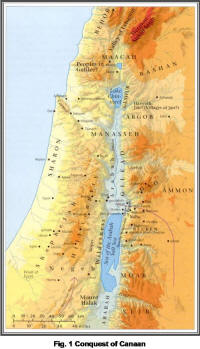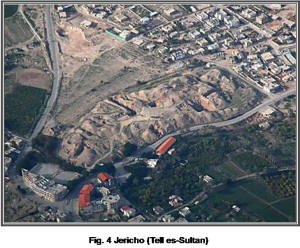Click to Expand
 After wandering in the wilderness for 40 years, Moses handed over leadership to Joshua, whose responsibility it was to bring the nation of Israel into the promised land of Canaan. After entering Canaan, Joshua had to go to war with the people who occupied the land. Canaan After wandering in the wilderness for 40 years, Moses handed over leadership to Joshua, whose responsibility it was to bring the nation of Israel into the promised land of Canaan. After entering Canaan, Joshua had to go to war with the people who occupied the land. Canaan was a land of city-states. There was no central government; each city had its own king. To conquer the land each city would have to be defeated.
At the time of the Conquest of Canaan by Israel Egypt was nominally in control of the region.
- Pharaoh Thutmose III (1504-1450) had added the region to Egypt’s domain.
- His son, Amenhotep II (1450-1424), Pharaoh of the Exodus, continued control.
- His son, Thutmose IV (1424-1414), Pharaoh while Israel was in the wilderness, was more interested in foreign alliances than military dominance.
o He had married the Asiatic daughter of Artatama, King of Mitanni. Mitanni was in northern Mesopotamia, mostly Hurrian.
- His son, Amenhotep III (1414-1378), who now ruled, was not interested in maintaining an empire. He was more concerned with domestic interests.
o The Tell el-Amarna letters depict him as ignoring the Canaanite pleas for help against the Hapiru.
o He left the individual cities of Canaan to themselves during the conquest by Israel.
Canaan culture was fairly advanced.
- Cities were well laid out, and houses showed good design and construction.
- Floors of buildings, were often paved, or plastered.
- Drainage systems had been developed.
- Workers were skilled in the use of copper, lead, and gold.
- Pottery was among the finest anywhere in the world.
- Extensive trade was conducted with foreign countries, including Egypt, Northern Mesopotamia, and Cyprus.
God commanded that all Canaanites be destroyed or driven from the land (Num. 33:51-56; Deut. 7:1-5).
- Had Israel done so, all would have been well; but she did not. Many Canaanites were allowed to remain, and Israel suffered the effects of their influence.
- This was the danger that God wanted to avoid.
o Many of the people accepted the worship of Canaanite Baal (fig. 2) rather than God.
o The attraction was that Baal was held to be god of rainfall and good crops. No doubt the Canaanites advised their new farming neighbors that technical skill was not enough to insure a good harvest, but that worship of Baal was still more important.
Moses’ strategy for taking Canaan, no doubt revealed to him by God, clearly had been to attack the land at its approximate midpoint, coming in from the east, and divide it into a south and north section, that each could be conquered separately.
- We may assume that Moses had shared this plan with Joshua, so that the new leader had the plan in mind as the people prepared for crossing the Jordan.
Reconnaissance
Jericho stood as a first and principal objective in the conquest of Canaan.
- Joshua sent two spies to make reconnaissance.
- The two crossed the Jordan and came to the city where they were protected by a harlot, Rahab, whose house was located on the city wall.
- When the men were detected, Rahab hid them beneath stalks of flax on the roof and then pointed the pursuers in the wrong direction.
- Convinced that Jericho would fall to Israel, Rahab requested safety for her and her family in return for her help. The men gave their promise and with further help escaped back to Joshua.
- Joshua learned from Rahab that the people feared Israel greatly. News of victories over Sihon and Og had reached Jericho.
Crossing the Jordan
The morning after the spies’ return, Joshua ordered the people to move to the bank of the Jordan. Shittim (exact location unknown), is where they encamped.
- It was spring and the Jordan was at flood stage. Before crossing three days were spent in final preparations and instructions.
- We may believe that during these three days the people wondered how all Israel could possibly cross the wide expanse of water flowing by them.
When everything was ready, the priests, carrying the ark, moved toward the river. The people, followed at a distance of 3000 feet (Josh. 3:4). This insured that a maximum number would see the ark as the guiding signal.
 - When the feet of the priests touched the water, it miraculously separated. As if stopped by a dam, the water from upstream that flowed toward them “stood up in a heap.” The other water continued its course to the Dead Sea, leaving a wide space for the people to cross (fig. 3).
- The priests bearing the ark stopped and remained in the middle of the river as the people moved past. As the people crossed, the water backed up approximately 15 miles upriver, as far as the city Adam.
o This gave testimony to each person that God was restraining the water.
o Adam is identified with Tell ed-Damieh about 20 miles from the Dead Sea. Israel crossed the Jordan opposite Jericho about five miles from the Dead Sea, so they were 15 miles from Adam. Since rockslides have occurred near Adam temporarily stopping the Jordan (once in AD 1267, 1906 and 1927), some have suggested that God used this means here.
- As soon as everyone had left the riverbed, the water was released and the river flowed again.
- Two memorials of this crossing were created, one in the Jordan and one across at Gilgal, where the people encamped (Josh. 4:1-24).
Gilgal
Gilgal now became a continuing center of Israelite activity. Its exact location is still uncertain, but clearly it was somewhere in the Jordan Valley between Jericho and the Jordan River (Josh. 4:19).
- From here, Jericho and Ai were soon taken.
- Later the Gibeonites came to Gilgal seeking a peace treaty (Josh. 9:6). From Gilgal Joshua led his army by forced march to help the Gibeonites against the southern confederacy (Josh. 10:6-7).
- From here, too, he went north to meet the northern confederacy (Josh. 11:6-14).
- And here the first allotment of tribal territories was made (Josh. 14:6). While the army was in the field fighting, the people remained at Gilgal as home base.
Three important events transpired soon after encampment.
- The circumcision of all the men (Josh. 5:2-9).
- The observance of the Passover (Josh. 5:10).
- The cessation of manna. God had supplied this food since the first year of travel(Exod. 16:14-22).
Defeat of Jericho
 Frequent biblical reference to Jericho shows that it was of major importance in the land. Jericho is well identified with Tell es-Sultan, five miles west of the Jordan and seven miles north of the Dead Sea. The mound covers about eight acres (fig. 4).
- After Jerusalem, Jericho is the most excavated site in Israel. Charles Warren in 1868 sank several shafts but concluded that nothing was to be found. Germans Sellin and Watzinger excavated 1907-13, Garstang 1930-36 and Kenyon 1952-58. Since 1997 an Italian-Palestinian team has been digging.
- Kenyon’s description of the walls of Jericho is significant.
o The walls were of a type, which made direct assault practically impossible. An approaching enemy first encountered a stone abutment 11 feet high, back and up from which sloped a 35o plastered scarp reaching to the main wall some 35 vertical feet above (fig. 5).
o The steep, smooth slope prohibited battering the wall by any effective device or building fires to break it.
o An army trying to storm the wall found difficulty in climbing the slope, and ladders to scale it could find no satisfactory footing.
God had plans for taking Jericho, which were revealed to Joshua in an unusual manner(Josh. 5:13-6:5).
- Joshua was met by one called the “commander of the army of the LORD.”
- “Commander of the army of the Lord,” could be the appearance of Christ as the Angel of God. This “Commander” called the ground “holy” (Josh. 5:15), as with Moses at the burning bush (Exod. 3:5), and used the personal pronoun “I” as giving Jericho into Joshua’s hand.
- The plans were to have “armed men,” led by seven priests carrying the ark, walk around the city once each day for six days and seven times on the seventh. At the close of the thirteenth circuit, the priests would blow trumpets and the people shout with a loud voice. When they did, the walls of the city would collapse and the army could enter.
The plan was executed as instructed.
- Thirteen times the city was circled and then the walls fell as the trumpets sounded and the people shouted. The army took the city with ease.
All the people of the city were killed, with the exception of Rahab and her family, whose lives were spared in keeping with the spies’ promise, and the city was leveled by fire. No Israelite was permitted to enrich himself by looting. God placed a ban on the city, declaring that it was “devoted” to Himself (Josh. 6:17-18).
- Spared, Rahab came to be included in the ancestral line of David and so of Christ(Matt. 1:5).
“The destruction was complete. Walls and floors were blackened or reddened by fire, and every room was filled with fallen bricks, timbers, and household utensils; in most rooms the fallen debris was heavily burnt.”
What caused the walls of Jericho to collapse?
- The common secular explanation is an earthquake must have caused the collapse.
o It must have been a very unusual earthquake because it struck in such a way as to allow a portion of the city wall on the north side of the site to remain standing, while everywhere else the wall fell.
- Rahab’s house was evidently located on the north side of the city.
o The Bible states that her house was built against the city wall. Before returning to the Israelite camp, the spies told Rahab to bring her family into her house and they would be spared. Rahab’s house was miraculously spared while the rest of the city wall fell.
o This is exactly what archaeologists have found. The preserved city wall on the north side of the city had houses built against it.
- The timing of the earthquake and the manner in which it selectively took down the city wall suggests something other than a natural calamity…It was God at work.
|
No comments:
Post a Comment